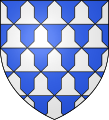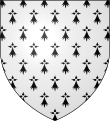It's a line that's been stuck in my mind for about thirty five years, so I should imagine it's there for good.
Gules (a horrid word) means red, though only usually if you're describing a heraldic shield or its accoutrements. (I imagine Keats was aiming to big up Madeleine's poshness, as well as her succulence.)
Heraldry employs a huge number of technical terms - there must be half a dozen words simply to describe the position a lion adopts on a shield (and even then the technical term for the lion is leopard) - but there are only seven colours (and two of them, yellow and white, count (again, technically) as metals).
Basically, we have:
Gules, vert, azure, sable, purpure, which are what we ordinary mortals would call red, green, blue, black and purple, respectively.
Then we have yellow and white, which are called or and argent, and which count as gold and silver.
There are also a couple of patterns, ermine and vair, which are called furs even though they come in colours and patterns never seen on any animal on Earth.
Here they are, first vair and then ermine:


See what I mean?
There are a few other variations in heraldic colours, but they're quite rare, so that's basically it.
Again, although there are many many rules of heraldry, with colours it's fairly simple: you can't put a coloured thing on a coloured background; a fur on a fur background; or a metal on a metal background.
Oh, and by the way, one other really useful term: if something on a shield is in its normal colours (like a kingfisher, perhaps) then it's called propre.
And thank heavens for that.
Word To Use Today: azure, perhaps, probably in its usual meaning of deep sky blue. It's come to us from Old French, from Old Spanish, from Arabic, from Persian lāzhuward, which means lapis lazuli.
No comments:
Post a Comment
All comments are very welcome, but please make them suitable for The Word Den's family audience.